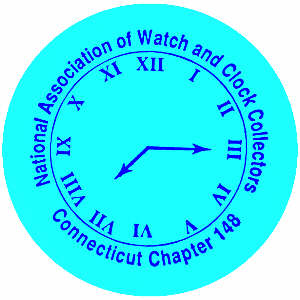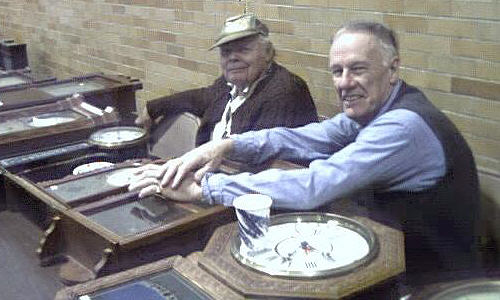Meetings PastMeeting Highlights - November 15, 2003
|
|||||||||
 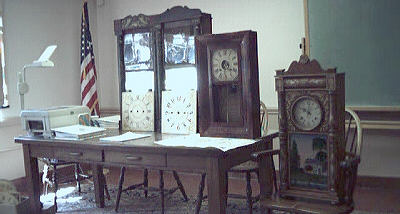 |
The title of Pat's talk was "Early Ohio Clocks and Their Connecticut Connections". During the first half of the 19th century there was much migration from New England to Ohio. Individuals known to have been heavily involved in the CT clockmaking industry such as George Marsh moved to Ohio during the 1830's.
Pat explained that as of 1832, Connecticut owned Ohio as part of its Western Reserve. Many towns in Ohio were named after Connecticut towns. Indeed, Pat's research made excellent use of early geography as a basis for analysis.
Early 19th century Ohio clocks essentially run the gamut between those completely made in Ohio to those completely made in Connecticut, with gradations in between. Examples of shelf clocks having "dishonest" overpasted labels are known, and examples with printers' lines surgically removed have been occasionally observed. This is suspected to have been done to obscure the clocks' CT origins.
Court and other archival records also reveal many connections between Ohio and CT tall clock makers. For example, Riley Whiting of Winchester, CT lent money to Lambert Lewis of Ohio. Lewis happened to have been born in Southington, CT. Tall clock movements themselves provide provocative evidence. For example, wheel counts of Lambert Lewis clocks are the same as those of Whiting's, leading to speculation that the connection between these men was more than financial.
Technology in the form of wheel cutting engines may have traveled. Examples of Ohio clocks have been found in unlikely places such as Nebraska, suggesting promulgation of CT marketing techniques. Talented individuals were known to have worked for both CT and Ohio clockmakers.
Pat reminded us that NAWCC member Paul Heffner, who passed away last December, was an acknowledged expert in Ohio clockmakers. Paul's work published in the Bulletin provides essential background for further reading and research in the topic of Ohio wooden movement clockmakers. Pat's recommendations for further reading also included Buckeye Horology by James Gibbs (1971). Pat thoughtfully provided copies of his bibliography. We warmly wish him the best of luck in his continuing endeavors.
--- Mary Jane Dapkus
* * *
TIMEXPO 2003 Highlights
by Mary Jane Dapkus
On Friday and Saturday, May 9 and 10, 2003, Connecticut Chapter 148 joined the Mid-Hudson Chapter 84, New England Chapter 8, New York Chapter 2, and the Timexpo Museum in Waterbury, CT, to host "Timexpo 2003". Friday evening's agenda included a reception at the museum, entertainment provided by the North End (Waterbury) Middle School Choir, tours and a presentation by John Garay, Director of Advanced Development for the Timexpo Corporation.
Saturday morning events featured a commodious mart held in the Kennedy High School gymnasium. Knowledgeable dealers offered many surprises and treasures.
Saturday morning's agenda also included educational presentations. Carl Listl's informative workshop entitled "Black Forest Carvings and Cuckoo Clock Repair" focused on woodcarving techniques essential to mastery of this specialized branch of restoration. Carl shared his extensive experience with a beautiful, elaborately carved sample restoration project.
Julio Correra, woodworking professional from New York City, presented an engaging session entitled "Veneer Repair and Wood Coloring". Born in Spain, Julio's unique perspective and words of wisdom set a congenial tone for the Timexpo, reminding us that there are no failures-only learning experiences in our respective quests for knowledge and skills.
The title of Daniel Nied's presentation was "Disassembly, Cleaning and Repair of Watches". Daniel is well known as director of the NAWCC School of Horology. Interestingly, scholars and archaeologists recently called upon Daniel to lend his considerable skills in opening and researching a watch found during the excavation of the Confederate submarine, the H. L. Hunley. The watch belonged to Lt. George Dixon, captain of the archaic Civil-War era submarine. (See the NAWCC web site for details.)
Afternoon events at the Timexpo Museum included self-guided and backstage tours highlighting the museum's collections and resources. The museum's collections are particularly strong in Waterbury Clock Company materials. The collections and exhibits trace connections between the area's historic firms and present day industries.
Presentations at the Timexpo Museum included that given by Will Andrewes entitled "The Art of the Timekeeper", and a panel discussion entitled "The Complex Role of the Clock Museum" with Connie Stuckert, Carl Rosa, Don Muller, Will Andrewes, Jim Whitney and Bob Frishman as Moderator. These dedicated museum professionals experience first-hand the challenges involved in interpreting and making great, technically complex clock and watch collections accessible to visitors. As might be imagined, museum visitors bring with them a wide range of backgrounds, knowledge, interests, and questions.
Special thanks is due to volunteers, presenters, and Timexpo staff whose efforts made this event not only possible but memorable.
|
Spotted at the Timexpo mart.
|
|
 |
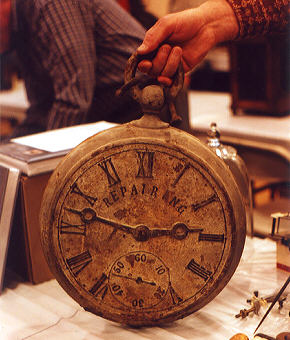 |
|
Japanese stick clock movement,
first half of the 19th century. |
Cast iron watch repairer's trade sign,
ca. 1860-1870. |
-- Mary Jane Dapkus
* * *
Meeting Highlights - March 15, 2003
by Mary Jane Dapkus
Connecticut Chapter 148 met early on Saturday, March 15, 2003, a notable morning for both a thick, melting snow pack and the intoxicating promise of a long-awaited spring. The meeting included refreshments, raffle, mart and technical presentation.
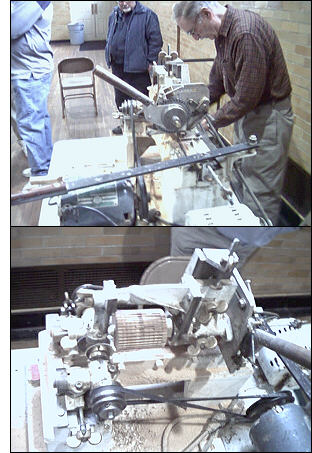 The meeting's feature presenter was an often-quoted wooden movement expert and Fellow of the NAWCC, our own chapter member, the irrepressible George Bruno. George's presentation focused on his discoveries relative to wooden gear cutting techniques employed by Eli Terry in the early 19th century. The discoveries grew out of curiosity, experimentation, intuition and deduction. Nevertheless, a chance Terry movement brought in George's shop for repair provided corroborating evidence for what might well have remained an elusive theory.
The meeting's feature presenter was an often-quoted wooden movement expert and Fellow of the NAWCC, our own chapter member, the irrepressible George Bruno. George's presentation focused on his discoveries relative to wooden gear cutting techniques employed by Eli Terry in the early 19th century. The discoveries grew out of curiosity, experimentation, intuition and deduction. Nevertheless, a chance Terry movement brought in George's shop for repair provided corroborating evidence for what might well have remained an elusive theory.
George demonstrated machinery developed as a result of his experiments and the supporting evidence from artifacts. Much of the effort involved in cutting gears was and is expended in cutting blanks. Gears were cut utilizing a pair of cutters operating on the leading edge of one tooth, the trailing edge of the adjacent tooth and on one crown at a time.
Black cherry for the gears was split in quarters using a froe and maul. With respect to pinions, George suspects that native mountain laurel wood was used not only because its slow growing habit retarded shrinkage, but also because the laurel was found in an advantageous diameter to minimize the need for turning down.
Cutting pinions remains more laborious and time consuming than cutting gears because each pinion must be cut individually. Cutting plates was a complex process involving locating holes for masking and counter-boring. Finally, George encouraged members to experiment with the tools and machinery he demonstrated.
George confided that he has spoken on the subject of early gear cutting technologies many times, in locations as far away as Dearborn (Michigan), Boston, Cincinnati, Syracuse and Portland (Maine). Regardless of the number of times it has ever been or will be told, this story of hard work and perseverance meeting the right artifact at the right place and time remains a source of sparkling joy and amazement.
-- Mary Jane Dapkus and Stan Dapkus
* * *
Meeting Highlights - January 18, 2003
by Mary Jane Dapkus
Despite low single digit temperatures, a spirited group of clock collectors, dealers and enthusiasts, including many from out-of-state, assembled at the Edmond Town Hall in the early morning hours of Saturday, January 18, 2003. Over piping hot cups of coffee, we enjoyed the company while examining many intriguing objects offered at the mart.
Mart offerings were particularly strong in clockmaking and watchmaking tools, reference books, quality watches, movements and mid-19th century shelf clocks. Wistfully recalling the camera left behind, several particularly interesting examples of decalcomania glass attracted attention, as well as a fine tall clock dial, a miniature ogee shelf clock, and a wonderful, rare gallery clock case.
By tradition, Chapter 148's January meeting does not include a technical speaker. However, chapter president Jim Katzin briefly discussed the New Year's upcoming events, including plans to continue the members' seminar series to be held at the American Clock and Watch Museum. The chapter will also focus on hands-on workshops, capitalizing on the abundance of members' technical skills. Members and guests are also encouraged to bring works-in-progress to the meetings for discussion, advice and assistance.
Best wishes for a happy and prosperous New Year!
-- Mary Jane Dapkus
